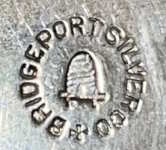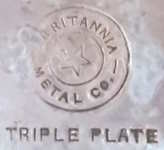MARKS AND HALLMARKS OF USA AND CANADA SILVERPLATE AND ELECTROPLATED SILVER MAKERS |
|
created by Giorgio B. owner of www.silvercollection.it © - HOME  |
|
This is a page of A Small Collection of Antique Silver and Objects of vertu, a 1500 pages richly illustrated website offering all you need to know about antique silver, sterling silver, silverplate, sheffield plate, electroplate silver, silverware, flatware, tea services and tea complements, marks and hallmarks, articles, books, auction catalogs, famous silversmiths (Tiffany, Gorham, Jensen, Elkington), history, oddities ... SITE MAP - HOME PAGE |
|
AMERICAN SILVER PLATE AND ELECTROPLATED SILVER - ALPHABETICAL LISTING OF MAKERS: -Bi-Bz - |
|
AMERICAN SILVERPLATE MARKS Aa / Al Am / Az Ba / Bh Bi / Bz C D E F G H I J K L Ma / Mh Mi / Mz N O P Q Ra / Rn Ro / Rz Sa / Sl Sm / Sz T U V Wa / Wd We / Wz X Y Z HOW TO READ, DECRYPT AND IDENTIFY THE MARKS ON AMERICAN SILVERPLATE AND ELECTROPLATED SILVER |
| Marks and information in AMERICAN STERLING SILVER section | BIGELOW, KENNARD & COMPANY |
 |
BIGGINS - RODGERS CO - Wallingford CTfounded in 1894 by Henry E. Biggins and Frank L. Rodgers. They purchased the machinery of the Hartford Silver Plate Co, Hartford, CT. In c.1915-1920 the firm was succeeded by Dowd-Rodgers Co |
| Marks and information in AMERICAN STERLING SILVER section | BINDER BROS. INC. |
| Marks and information in AMERICAN STERLING SILVER section | BINGHAM & WALK |








further marks and information in AMERICAN STERLING SILVER section |
HENRY BIRKS & SONS - Montreal, Quebec, Canada Established by Henry Birks in 1879. The firm became Henry Birks & Sons in 1893. Incorporated as Henry Birks & Sons Ltd in 1905. The firm used the trade marks "Garb of wheat" RIDEAU PLATE (registered in 1925) and figural "SPHINX" (possibly as retailer) |

 |
BIRMINGHAM SILVER CO INC - Brooklyn, NY and later Yalesville, CT The company was the successor to the Goldfeder Silver Co., founded by Sol Goldfeder in 1932. The company became Birmingham Silver Co. sometime before 1957. Successors to Goldfeder Silverware Co. |
| Marks and information in AMERICAN STERLING SILVER section | R.BLACKINTON & CO |






 |
W. & S. BLACKINTON CO - Meriden CT founded in 1865. Acquired by Ellmore Silver Co in 1938. Independently owned and incorporated since 1961. Purchased by Raimond Silver Mfg. Co, Meriden in 1966 and moved to Chelsea, MA |
The two common forms of plated silver are Sheffield plate and silverplate/electroplate.
Sheffield Plate is a cheaper substitute for sterling, produced by fusing sheets of silver to the top and bottom of a sheet of copper or base metal. This 'silver sandwich' was then worked into finished pieces. At first it was only put on one side and later was on top and bottom.
Modern electroplating was invented by Italian chemist Luigi V. Brugnatelli in 1805. Brugnatelli used his colleague Alessandro Volta's invention of five years earlier, the voltaic pile, to facilitate the first electrodeposition. Unfortunately, Brugnatelli's inventions were repressed by the French Academy of Sciences and did not become used in general industry for the following thirty years.
Silver plate or electroplate is formed when a thin layer of pure or sterling silver is deposited electrolytically on the surface of a base metal. By 1839, scientists in Britain and Russia had independently devised metal deposition processes similar to Brugnatelli's for the copper electroplating of printing press plates.
Soon after, John Wright of Birmingham, England, discovered that potassium cyanide was a suitable electrolyte for gold and silver electroplating.
Wright's associates, George Elkington and Henry Elkington were awarded the first patents for electroplating in 1840. These two then founded the electroplating industry in Birmingham England from where it spread around the world.
Common base metals include copper, brass, nickel silver - an alloy of copper, zinc and nickel - and Britannia metal-a tin alloy with 5-10% antimony. Electroplated materials are often stamped EPNS for electroplated nickel or silver, or EPBM for electroplated Britannia metal.
Sheffield plate by the fusion process was not made in America, but factories here did turn out quantities of electroplated silver. In fact, it was so popular that one English firm with several variations of its name, but all including Dixon, sold quantities of electroplated silver, issued catalogues, and even had a New York showroom.
Today there is a great deal of American plated silver which has been treasured for years. Many families had plated silver as well as fine sterling. Some of it was inherited; some prized for sentimental reasons. If you have this plated ware, and it is as dear to you as fine early silver, then you are among the happy people of this world.
On plated silver the terms 'triple' and 'quadruple' indicate the number of coatings received by the base metal in the electroplating process. Naturally the more metal used in the plating the longer the piece should last. Polishing and wear have taken their toll of much of this plated ware and whether pieces are worth replating depends on their usefulness and your pleasure in them. If you like them well enough to spend money on them, then by all means have the work done, but remember a piece is worth at market value only the metal that is in it, the base metal under the plating being worth very little.
E.P.N.S. (Electroplated Nickel Silver) and EPBM (Electroplated Britannia Metal) are the most common names attributed to silver plate items. But many other names are used for silver plate:
EPWM, Electroplate on White Metal, EPC, Electroplate On Copper, EPCA, Electro Plated Copper Alloy, EPGS - Electro Plated German Silver, EPMS - Electro Plated Magnetic Silver, African Silver, Albion Silver, Alpha Plate, Ambassador Plate, Angle Plate, Argentium, Argentine Plate, Argentum, Ascetic, Austrian Silver, Brazilian Silver, Britanoid, Cardinal Plate, Electrum, Embassy Plate, Encore, Exquisite, Insignia Plate, Kingsley Plate, New Silver, Nevada Silver, Norwegian Silver, Pelican Silver, Potosi Silver, Royal County Plate, Silva Seal, Silverite, Sonora Silver, Spur Silver, Stainless Nickel, Stainless Nickel Silver, Unity Plate, Venetian Silver, Welbeck Plate,
| STERLING SILVER OF USA AND CANADA |
| SILVER MANUFACTURERS: MARKS, HISTORY AND INFORMATION |






 Fabergé Gorham International Silver Co Georg Jensen Kirk Stieff Meriden Britannia Reed & Barton Rogers Tiffany & Co Towle Wallace Wiener Werkstatte WMF |
|




















